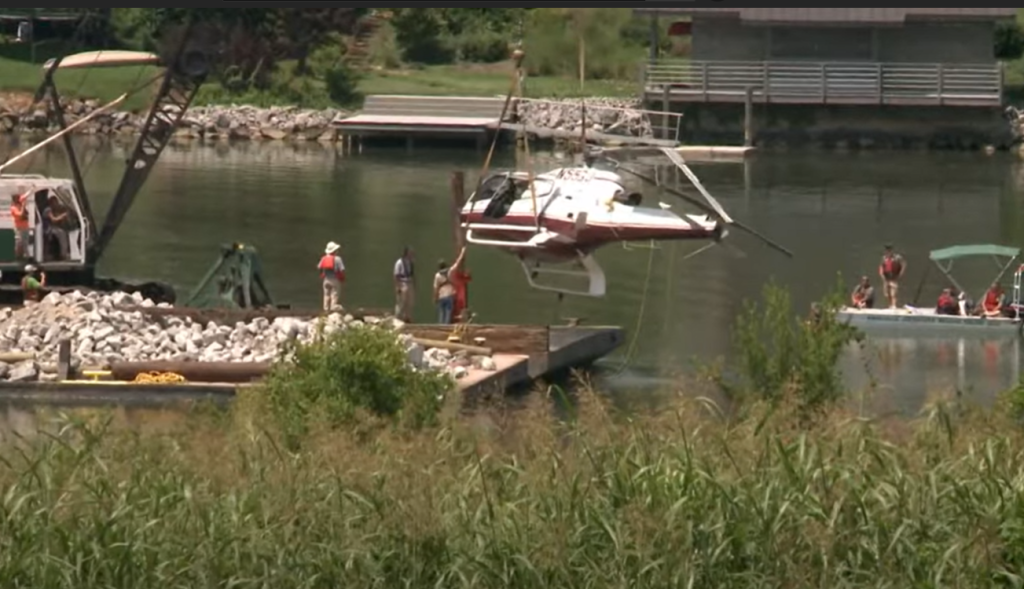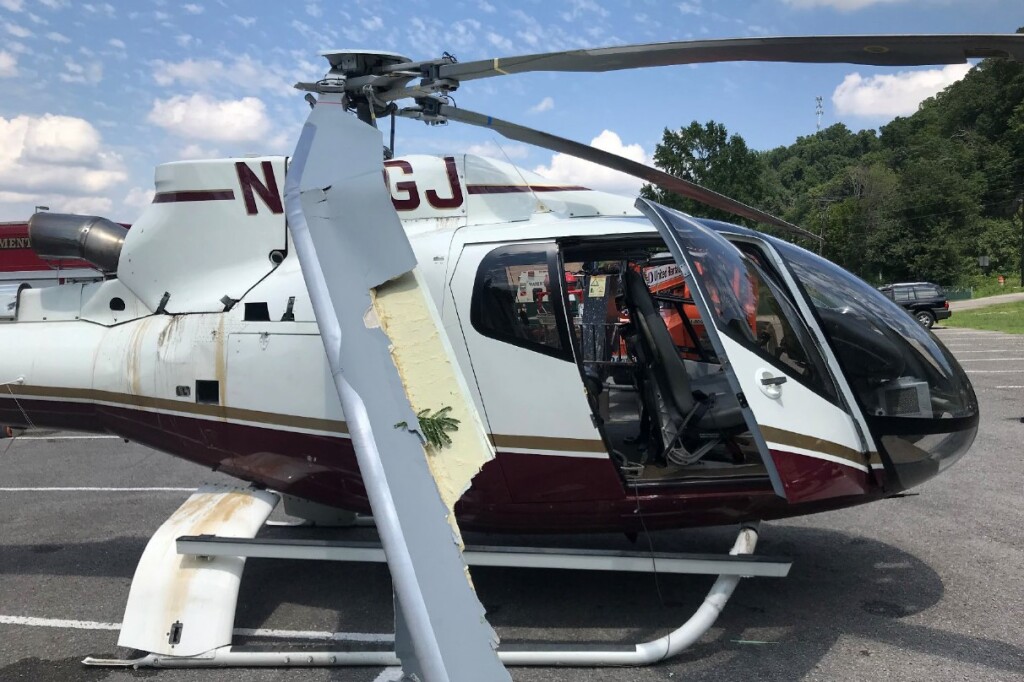Fatal EC130B4 Water Impact in the Tennessee River after “Entry to VRS” Say NTSB (N55GJ)
On 3 August 2020 a privately owned Airbus EC130B4 N55GJ impacted the Tennessee River near Knoxville, Tennessee. One passenger, 84 year old local business man Joe Clayton, was fatally injured although the other three occupants escaped uninjured.

News Video: Recovery of the Wreckage of Airbus EC130B4 N55GJ from the Tennessee River, Knoxville, TN
History of the Flight
The US National Transportation Safety Board (NTSB) safety investigation report, issued 28 June 2022, explains that the helicopter was making a local flight from McGhee Tyson Airport
(TYS), Knoxville with the intention of landing at the pilot’s riverside property. The pilot, the deceased passenger’s 86 year old brother, had 12600 hours of flight experience, 300 on type.
The pilot made a right circling approach at 1000-1200 ft AMSL. The landing site was at c840 ft AMSL according to one mapping site. The pilot stated…
…he “was descending with low power and a 25° angle of descent, slowing to come to a hover at low speed over the water.” He…was planning to hover taxi to the landing site at a height about 75 feet above the water and that when he added power to arrest the descent, the helicopter “started to settle.”
The pilot is said to have commented to another pilot the next morning that he made a “steep approach” with “little-to-no airspeed” and a rate of descent “greater than 300 feet per minute”.
He stated he “pulled max power to stop the settling,” but it was as if the helicopter “didn’t have any power” and it continued to descend until it impacted the river.

Flight Path of Airbus EC130B4 N55GJ – Based on ADS-B Data (Credit: NTSB) – Note the landing site elevation does not agree with open source mapping data which suggests 850 ft AMSL
A passenger reported the helicopter to have been level when it descended and…
…the left “skid hit and then rotor hit” and the helicopter was “torqued into the water on the left side.”
The pilot and two passengers were able to egress before the helicopter sank. The helicopter came to rest on the bottom of the Tennessee River about 435 ft from the intended landing site. The body of the fourth occupant, seated in the front left seat, was recovered by divers later that evening.
The autopsy report noted..[the deceased]…was free-floating in the fuselage and not restrained at the time of recovery.
Safety Investigation
Damage to the helicopter was “consistent with a low-energy impact”.

Wreckage of Airbus EC130B4 N55GJ After Salvage from the Tennessee River, Knoxville, TN (Credit: Airbus via NTSB)
No pre-impact malfunctions were identified.
The…vehicle and engine monitoring display and a digital engine control unit…stored records of failure messages associated with engine operations. The data revealed no failures or limit exceedances prior to impact and indicated the engine was running at the time of impact.
Weather reports and statements from the pilot and witnesses indicated that the helicopter descended steeply with little forward airspeed and a tailwind of about 5 knots…
The NTSB highlight that the FAA’s Helicopter Flying Handbook (FAA-H-8083-21B) described the aerodynamic condition of Vortex Ring State (VRS) and states:
Situations that are conducive to a VRS condition are attempting to hover out of ground effect (OGE) without maintaining precise altitude control, and approaches,
especially steep approaches, with a tailwind component.
According to ESPN-R / EHEST Leaflet HE 1 Safety Considerations, VRS…
…is likely to occur when descending in powered flight at an airspeed below 30 Kts with a Rate of Descent (ROD) close to the main rotor “downwash velocity”.
Downwash velocity (or induced velocity) is defined as the airspeed of the airflow drawn down through the rotor disc (Froude formula). The induced velocity is a function of the helicopter type and gross weight. For example, a three bladed helicopter with a rotor diameter of 10.69m and a weight of 2,250 kg would result in an induced velocity of 10 m/s (2000 ft/min). Whereas, for a two bladed helicopter type with a rotor diameter of 11m and a weight of 1,000 kg the induced velocity is 6.5 m/s (1300 ft/min.). Therefore, although Vortex Ring State is shown to be dependant on the helicopter type and weight, a commonly accepted unsafe ROD is considered to be in excess of 500 ft/min.
While there is much discussed about recovery from VRS, avoidance is even more critical.
Since the recovery actions will entail a considerable loss of height, it is imperative to avoid Vortex Ring especially when close to the ground. …the following operations should be conducted with great care:
• Confined areas recce and approaches
• Downwind approaches
• Steep approaches
• Hover Out of Ground Effect (HOGE)
• Low speed autorotation recovery
• Downwind quick stops
• Aerial photography
NTSB Probable Cause
The pilot’s entry into vortex ring state and his inability to arrest the helicopter’s descent while maneuvering for landing.
Safety Resources
The European Safety Promotion Network Rotorcraft (ESPN-R) has a helicopter safety discussion group on LinkedIn. You may also find these Aerossurance articles of interest:
- French Cougar Crashed After Entering VRS When Coming into Hover
- Vortex Ring State: Virginia State Police Bell 407 Fatal Accident
- Grand Canyon Air Tour Tragic Tailwind Landing Accident
- US Air Ambulance Near Miss with Zip Wire and High ROD Impact at High Density Altitude
- Dutch Maritime NH90 Caribbean Accident: Focus on the Survivability Issues
- Dramatic Malaysian S-76C 2013 Ditching Video
- AAIB Report on 2013 Sumburgh G-WNSB AS332L2 Helicopter Accident
- Fatal Mi-8 Loss of Control – Inflight and Water Impact off Svalbard
- Canadian Coast Guard Helicopter Accident: CFIT, Survivability and More
- Night Offshore Winching CFIT
- Helicopter Ditching – EASA Rule Making Team RMT.0120 Update
- NTSB Report on Bizarre 2012 US S-76B Ditching
- AAIB Report on the Ditchings of EC225 G-REDW 10 May 2012 & G-CHCN 22 Oct 2012
- Korean Kamov Ka-32T Fire-Fighting Water Impact and Underwater Egress Fatal Accident
- CAP1145 Helicopter Water Impact Survivability Statistics – A Critique
- Beware Last Minute Changes in Plan
- Inappropriate Autorotation Training
- Alaskan AS350B3e Accident: Botched Autorotation Practice?
- Torched Tennessee Tour Trip (B206L N16760)
- EC130 Door Loss Damaged Main Rotor Blades
- Hawaiian Air Tour EC130T2 Hard Landing after Power Loss (Part 1)
- Hawaiian Air Tour EC130T2 Hard Landing after Power Loss (Part 2 – Survivability)
- EC130B4 Loss of Control on Take-Off in Dubai
- EC130B4 Accident: Incorrect TRDS Bearing Installation
- EC130B4 Destroyed After Ice Ingestion – Engine Intake Left Uncovered
- Air Ambulance Leaps into Air: Misrigged Flying Controls
- UPDATE 9 July 2022: R44 Ditched After Loss of TGB & TR: Improper Maintenance

Recent Comments